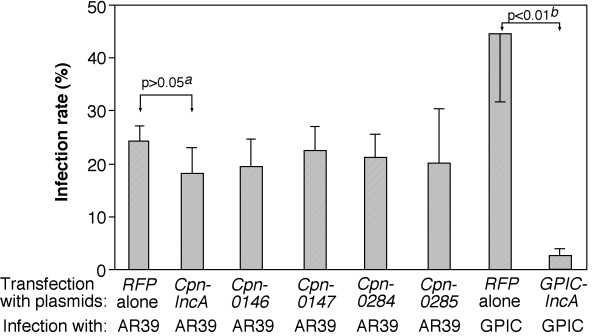Figure 6.
Effects of RFP-Cpn fusion protein expression on the subsequent chlamydial infection. HeLa cells transfected with pDsRed plasmids coding for various RFP fusion proteins as listed along the X-axis were subjected to infection with either C. pneumoniae AR39 or C. caviae GPIC organisms. 72 (for AR39) or 40 hours (for GPIC) after infection, the cultures were subjected to immunostainings for visualizing RFP fusion proteins (red), chlamydial organisms (a rabbit anti-CT395 IgG plus a Cy2-conjugaed goat anti-Rabbit IgG; green) and DNA (Hoechst, blue). The slides were viewed under a conventional fluorescence microscope. Approximately 100 red cells from 5 to 10 random views were counted in each experiment and the % of cells infected with chlamydial organisms was calculated. The results from three independent experiments were expressed as mean values plus/minus standard errors. A two-tailed Student t test was used to analyze the results. Note that expression of RFP-Cpn fusion proteins (including CpnIncA) failed to significantly alter the susceptibility of the transfected cells to C. pneumoniae AR39 organism infection while the expression of RFP-GPICIncA prevented the subsequent infection with GPIC organisms. "a" indicates statistically insignificant difference (P > 0.05) while "b" indicates a highly significant difference (P < 0.01).

